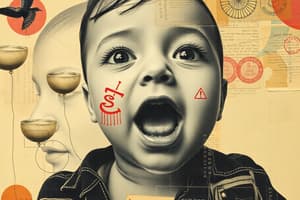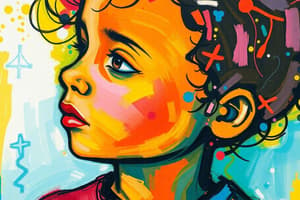Podcast
Questions and Answers
What is emotion?
What is emotion?
Feeling, or affect, that occurs when a person is in a state or an interaction that is important to them, especially to their well-being.
Emotions have important roles in communication with others and __________.
Emotions have important roles in communication with others and __________.
behavioral organization
Almost all classifications designate an emotion as either ________ or ________.
Almost all classifications designate an emotion as either ________ or ________.
positive, negative
Emotions are influenced both by _________ __________ and by a person's ____________.
Emotions are influenced both by _________ __________ and by a person's ____________.
What do babies pick up on concerning their mothers?
What do babies pick up on concerning their mothers?
What are display rules?
What are display rules?
Display rules are _______ ________.
Display rules are _______ ________.
Name some of the emotions that infants express in the first 6 months of life.
Name some of the emotions that infants express in the first 6 months of life.
When do self-conscious emotions occur according to Kagan and Campos?
When do self-conscious emotions occur according to Kagan and Campos?
Interactions between parents and infants are ________ ________.
Interactions between parents and infants are ________ ________.
What is described as a Basic cry?
What is described as a Basic cry?
Describe an anger cry.
Describe an anger cry.
What characterizes a pain cry?
What characterizes a pain cry?
What is a reflexive smile?
What is a reflexive smile?
A social smile occurs as early as _____ months of age.
A social smile occurs as early as _____ months of age.
One of a baby's earliest emotions is ______, typically around 6 months.
One of a baby's earliest emotions is ______, typically around 6 months.
Stranger anxiety usually appears around ____ months, and intensifies by _____ months.
Stranger anxiety usually appears around ____ months, and intensifies by _____ months.
When infants feel ______, they are less likely to show stranger anxiety.
When infants feel ______, they are less likely to show stranger anxiety.
Infants are _____ fearful of child strangers and friendly, outgoing strangers than adult strangers and passive, unsmiling strangers.
Infants are _____ fearful of child strangers and friendly, outgoing strangers than adult strangers and passive, unsmiling strangers.
What is separation protest?
What is separation protest?
Separation protest tends to peak around _____ months among U.S. infants.
Separation protest tends to peak around _____ months among U.S. infants.
What is social referencing?
What is social referencing?
During the ______ year, infants gradually develop the ability to inhibit emotional responses.
During the ______ year, infants gradually develop the ability to inhibit emotional responses.
By age ____ children can define their feeling states and identify upsetting contexts.
By age ____ children can define their feeling states and identify upsetting contexts.
Even at birth, babies have different __________.
Even at birth, babies have different __________.
What are individual differences in behavioral styles, emotions, and characteristic ways of responding called?
What are individual differences in behavioral styles, emotions, and characteristic ways of responding called?
What classification system includes easy child, difficult child, and slow-to-warm-up child?
What classification system includes easy child, difficult child, and slow-to-warm-up child?
What characterizes an easy child?
What characterizes an easy child?
What characterizes a difficult child?
What characterizes a difficult child?
What characterizes a slow-to-warm-up child?
What characterizes a slow-to-warm-up child?
Chess and Thompson found their classifications to be relatively _______ across the childhood years.
Chess and Thompson found their classifications to be relatively _______ across the childhood years.
Kagan regards shyness as one feature of which temperament category?
Kagan regards shyness as one feature of which temperament category?
What characterizes inhibition of the unfamiliar?
What characterizes inhibition of the unfamiliar?
What is effortful control (self-regulation)?
What is effortful control (self-regulation)?
Infants with mothers who are __________ show a lower level of effortful control.
Infants with mothers who are __________ show a lower level of effortful control.
What do Kagan argue that children inherit that predisposes them to have a certain temperament?
What do Kagan argue that children inherit that predisposes them to have a certain temperament?
An infant's temperament may depend in part on __________.
An infant's temperament may depend in part on __________.
What is meant by goodness of fit?
What is meant by goodness of fit?
What are some strategies for temperament-sensitive parenting according to Sanson and Rothbart?
What are some strategies for temperament-sensitive parenting according to Sanson and Rothbart?
What is attention to and respect for individuality?
What is attention to and respect for individuality?
What does structuring the child's environment involve?
What does structuring the child's environment involve?
Why should negative labels not be applied to children?
Why should negative labels not be applied to children?
Emotions and temperament are key parts of __________.
Emotions and temperament are key parts of __________.
According to Erikson, the first year of life is characterized by which stage of development?
According to Erikson, the first year of life is characterized by which stage of development?
The trust-versus-mistrust stage of development arises with each successive stage and must again be dealt with, and the outcomes can be __________ or __________.
The trust-versus-mistrust stage of development arises with each successive stage and must again be dealt with, and the outcomes can be __________ or __________.
A rudimentary form of self-recognition appears as early as _______ months.
A rudimentary form of self-recognition appears as early as _______ months.
The ability to recognize one's features appears between ______ months to ______ years.
The ability to recognize one's features appears between ______ months to ______ years.
Infants develop a conscious awareness of their own bodies in the _____ year of life.
Infants develop a conscious awareness of their own bodies in the _____ year of life.
What important issue does Erikson stress in the second year of life?
What important issue does Erikson stress in the second year of life?
What are the implications of the autonomy versus shame and doubt stage?
What are the implications of the autonomy versus shame and doubt stage?
Whose view describes infants as socioemotional beings motivated to understand their social world?
Whose view describes infants as socioemotional beings motivated to understand their social world?
Face-to-face play typically begins around - months of age.
Face-to-face play typically begins around - months of age.
Infants as young as ____ months show interest in each other.
Infants as young as ____ months show interest in each other.
Between -_ months, children increase their imitative and reciprocal play.
Between -_ months, children increase their imitative and reciprocal play.
What is locomotion?
What is locomotion?
The ability to perceive people as engaging in intentional and goal-directed behavior occurs towards the end of the _______ year.
The ability to perceive people as engaging in intentional and goal-directed behavior occurs towards the end of the _______ year.
What is attachment?
What is attachment?
According to Freud, infants become attached to the person or object that provides them with _____ __________.
According to Freud, infants become attached to the person or object that provides them with _____ __________.
What did Harlow's work with infant monkeys show?
What did Harlow's work with infant monkeys show?
According to Erikson, physical comfort and sensitive care are key to establishing trust in the _______ stage of development.
According to Erikson, physical comfort and sensitive care are key to establishing trust in the _______ stage of development.
Who argued that both the infant and its primary caregivers are biologically predisposed to form attachments?
Who argued that both the infant and its primary caregivers are biologically predisposed to form attachments?
Bowlby conceptualized ______ phases in the development of attachment.
Bowlby conceptualized ______ phases in the development of attachment.
Bowlby's phase which lasts from ______ to ______ months involves infants forming attachments to human figures.
Bowlby's phase which lasts from ______ to ______ months involves infants forming attachments to human figures.
Bowlby's phase which lasts from ______ to ______ months involves attachment focusing on one figure.
Bowlby's phase which lasts from ______ to ______ months involves attachment focusing on one figure.
Bowlby's phase which lasts from ______ to ______ months involves developing specific attachments.
Bowlby's phase which lasts from ______ to ______ months involves developing specific attachments.
Bowlby's phase which lasts from ______ _______ ______ involves taking into account other people's feelings and plans.
Bowlby's phase which lasts from ______ _______ ______ involves taking into account other people's feelings and plans.
What is an internal working model?
What is an internal working model?
What observational measure of infant attachment did Ainsworth create?
What observational measure of infant attachment did Ainsworth create?
What characterizes securely attached babies?
What characterizes securely attached babies?
What characterizes insecure avoidant babies?
What characterizes insecure avoidant babies?
What characterizes insecure resistant babies?
What characterizes insecure resistant babies?
What characterizes insecure disorganized babies?
What characterizes insecure disorganized babies?
Do individual differences in attachment matter?
Do individual differences in attachment matter?
What did Sroufe find correlated with positive emotional health in children?
What did Sroufe find correlated with positive emotional health in children?
What is the developmental cascade model?
What is the developmental cascade model?
What were the findings of the meta-analysis study on the developmental cascade model?
What were the findings of the meta-analysis study on the developmental cascade model?
What are the criticisms of attachment theory?
What are the criticisms of attachment theory?
Caregivers of securely attached babies interact by being sensitive to their signals and being constantly available.
Caregivers of securely attached babies interact by being sensitive to their signals and being constantly available.
Interactions between children and parents have effects on _______ ________ and ________ as well as ________.
Interactions between children and parents have effects on _______ ________ and ________ as well as ________.
What is reciprocal socialization?
What is reciprocal socialization?
In the U.S., _______ of children age 5 and younger experience more than one child care arrangement.
In the U.S., _______ of children age 5 and younger experience more than one child care arrangement.
The European Union has mandated ________ maternity leave, most of which are paid.
The European Union has mandated ________ maternity leave, most of which are paid.
The United States currently allows up to _________ of unpaid leave for parents who are caring for a newborn.
The United States currently allows up to _________ of unpaid leave for parents who are caring for a newborn.
Flashcards are hidden until you start studying
Study Notes
Emotions in Infancy
- Emotions are crucial for well-being and influence interactions and communication.
- Emotions are classified as positive or negative, impacting developmental progress.
- Biological foundations and personal experiences shape an individual's emotional response.
Impact of Stress and Emotional Expression
- Babies sense maternal stress; higher stress correlates with increased infant heart rates.
- Display rules dictate when and how emotions should be expressed and are not universal.
- Infants express basic emotions such as surprise, joy, anger, sadness, fear, and disgust within the first 6 months.
Development of Self-Conscious Emotions
- Self-conscious emotions develop after the first year, focusing on self-awareness and social interaction.
- Parent-infant interactions are characterized by mutual regulation and responsiveness.
Crying and Smiling Patterns
- The basic cry indicates hunger, while the anger cry expresses frustration and has an intensified airflow.
- The pain cry features a sudden loud cry following breath cessation.
- Reflexive smiles appear in early infancy, while social smiles emerge around 2 months in reaction to stimuli.
Fear Development and Attachment
- Fear typically starts around 6 months and peaks at 18 months, with stranger anxiety emerging in this period.
- Separation protest peaks around 15 months, demonstrating the emotional bond with caregivers.
Social Referencing and Emotional Regulation
- Infants engage in social referencing, interpreting others' emotional cues to guide their behavior.
- By the first year, infants learn to manage emotional responses, and by age two, they can articulate feelings.
Temperament Variability
- Individual temperaments vary from birth, classified into easy, difficult, and slow-to-warm-up categories.
- A stable temperament is observed across childhood stages, influencing behavior and personality post-development.
Inhibition of the Unfamiliar
- Shyness is one aspect of the broader temperament category of inhibition towards unfamiliar situations.
Parental Influence on Development
- Sensitive and responsive caregiving fosters better emotional regulation and secure attachments, enhancing child development.
- Strategies include respecting individuality, structuring environments, and avoiding negative labeling.
Theories of Attachment
- Attachment is defined as a close emotional bond, with Freud attributing it to oral satisfaction and Bowlby positing biological predispositions.
- Bowlby outlines four phases of attachment development:
- Phase 1 (birth to 2 months): Initial attachment towards human figures.
- Phase 2 (2 to 7 months): Attachment focuses on one primary caregiver.
- Phase 3 (7 to 24 months): Development of specific attachments increases active seeking of caregivers.
- Phase 4 (24 months onward): Awareness of others' feelings and intentions.
Attachment Measurement
- Ainsworth's "Strange Situation" identifies secure and insecure attachment styles, including:
- Securely attached: Use caregivers as a secure base for exploration.
- Insecure avoidant: Avoid the caregiver.
- Insecure resistant: Cling to caregivers while resisting closeness.
- Insecure disorganized: Display disorientation and confusion.
Long-Term Effects of Attachment
- Early secure attachments positively correlate with social competence, self-esteem, and emotional health in later life.
- The developmental cascade model links various developmental domains over time, emphasizing the role of social contexts.
Parenting Context and Child Development
- Reciprocal socialization emphasizes the bidirectional influence between children and parents.
- High percentages of U.S. children experience multiple childcare arrangements, affecting development outcomes.
- The European Union mandates 14 weeks of paid maternity leave, while the U.S. offers 12 weeks of unpaid leave, highlighting different cultural approaches to parental leave policies.
Studying That Suits You
Use AI to generate personalized quizzes and flashcards to suit your learning preferences.




